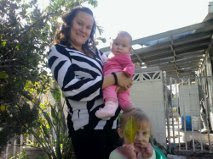Section 1: Safety Practices and Procedures
Angela Van Rosmalen
03/12/10
In working with preschoolers there are some potentially hazardous safety threats that are common to the age group of children 3-5. Five potential situations/ safety threats are outdoor equipment, play space, water safety, toy safety, and age- appropriate activities and equipment.
For outdoor equipment children love to climb and run so there needs to be measures used to ensure the safety of the children. Outdoor equipment needs to have shock absorbers, and padded equipment to prevent and aid in falls if they might happen. Hazardous threats in outdoor equipment include those made of metal which can rust and cause cuts if they break, and others are made out of wood which can splinter. Plastic equipment is modern and safer to use (Robertson, C. 2010, p.147-48).
A child’s play space is the area in the early childhood environment in which the children play and use to exercise in. The space needs to accommodate all of the children and be safe for all of them. Also, teacher supervision must be present at all times to ensure safety of the children. The play space has to be large enough for each child to play and exercise in. Safety measures can include making sure that the teacher has an eye on the whole space being used by the children in order to ensure proper supervision, the equipment has to be separate from other areas so that children can avoid collisions, and the levels of the play equipment has to support the size and stature of the children.
For water safety in a childcare setting the water temperature cannot reach a scalding point because of the risk of burns. Also, if there are pools or bodies of water nearby there should be adequate fencing and covers to aid in the prevention of drowning. Safety policies include supervision of children at all times, and have the required devices such as floatation devises and teachers’ assistants to aid in the pool.
Toy safety for 3-5 year old must be age- appropriate and to keep them safe from injury. Toys should accommodate learning and riding toys should be "sturdy and be well- balanced" (Robertson, C. (2010). p.148). Also teachers need to avoid children from playing with small toys to prevent them from swallowing them or choking on them. Teachers also need to make sure that the children are assisted in taking turns so they prevent them falling or getting injured on riding toys and gym areas. Toys need to be inspected prior to introducing them to the children and recall lists need to be watched and reviewed often.
Activities need to be age-appropriate for the children. Toys are labeled upon manufacturing so when the consumer purchases them, the cautions and hazards and age limits are displayed. It is a good idea to pay attention to the limitations before purchasing toys. Some regulations include making sure the toys are appropriate for the children and the toys accommodate the different age groups. Also, supervision is a must in the play environment.
Families can ensure the safety of the children at home by reading directions to labels, reading safety books, and going online to research safety guidelines for children of specific ages. Also, parents can talk to the teacher of the child's care facility to gain knowledge on how safety issues are practiced there. Here, parents can work with teachers to develop partnerships on their children's safety and health.
Resources
Robertson, C. (2010). Safety, nutrition, and health in early education (4th ed.). Belmont, CA: Wadsworth/Cengage Learning.

Hi Angela, I enjoyed reading your blogs. Safety is very important. Parents can help at home. Many times, that's the challenge to get the parents more invloved. If all involved can parntnership together, especially to communicate more would be effective. Enjoyed being in class together.
ReplyDeleteYour blog was very informing and interesting. I liked that you wrote how it needs to be safe and appropriate for all children because alot of the times children are in mixed age groups and includes children with disabilities and developmental delays and it can make a difference with safety issues.
ReplyDelete